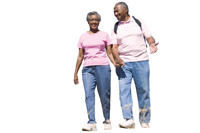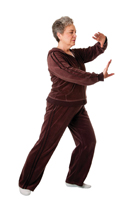Moving Through Chemotherapy
Light exercise can help most cancer patients counteract the fatigue of treatment
When it comes to exercise, we often hear—and tell ourselves—a lot of excuses. It’s too hot outside. The gym’s too packed. No time today.
One that is not heard too often is, “I’m in chemotherapy.” That’s a reason that no one would question.
.jpg?sfvrsn=e602417_1)
However, studies have shown that most patients who are undergoing chemotherapy treatment can benefit from exercise, and physicians like Gary Thomas, MD, have seen it help their patients.
“I have seen firsthand the benefits that most patients who exercise during chemotherapy receive,” Dr. Thomas says. “Perhaps the most common complaint that I hear from patients undergoing chemotherapy is the significant fatigue that they are experiencing. My #1 prescription for these patients is to exercise as much as possible.”
Dr. Thomas is a board-certified medical oncologist and the Medical Director at St. Joseph’s/Candler SC Cancer Specialists in Hilton Head and Okatie, South Carolina.
“Back in the day, it was thought that people suffering from cancer who were undergoing chemotherapy should ‘take it slow ‘ and that exercise may compound the side effects that they might be experiencing,” Thomas explains. He has met patients who felt, and some who still do feel, that exercise for them is not safe.
“I believe that nothing could be further from the truth for most patients,” Thomas says. “Of course, each patient's situation is unique and the recommendation for exercise must come from their personal oncologist.”
Patients undergoing chemotherapy may stop exercising in the belief that they are conserving energy. However this approach can become a vicious cycle: the less the patient exercises, the weaker they become.
“I tell patients that even just getting out and walking a bit is better than nothing,” Thomas says. “Once they start walking in general they will start feeling better and will want to exercise even more. Often a patient may experience less pain, such as muscle or joint aches, as well as less nausea and even less anxiety and depression. Some studies have also shown that the effects of peripheral neuropathy, a common side effect of many chemotherapy drugs, can be minimized with exercise.”
Multiple factors such as a patient’s age, overall health status, type of cancer, and chemotherapy regimen needs to be considered before an exercise program is prescribed. For example, older patients or those with cancer involving the bone could
be at higher risk for fractures. Or certain patients’ immune status might preclude them from going to a public gym. However, in general, an effective program for cancer patients is not dissimilar to a basic program for most people:

- An aerobic workout of moderate intensity: brisk walking, jogging, cycling, swimming
- Strength training: Lifting weights, resistance machines, resistance bands
- Stretching to help muscles stay limber and to avoid injury

Personal trainers and exercise physiologists can provide advice to both the patient and the oncologist, if needed, as they develop a plan. The crucial point that Dr. Thomas hopes patients will remember is that engaging in activity, rather than avoiding it, is what will actually help the patients feel better as they go through treatment.
“In my practice, I have seen benefits in terms of not only more energy but also overall better quality of life,” Thomas says.